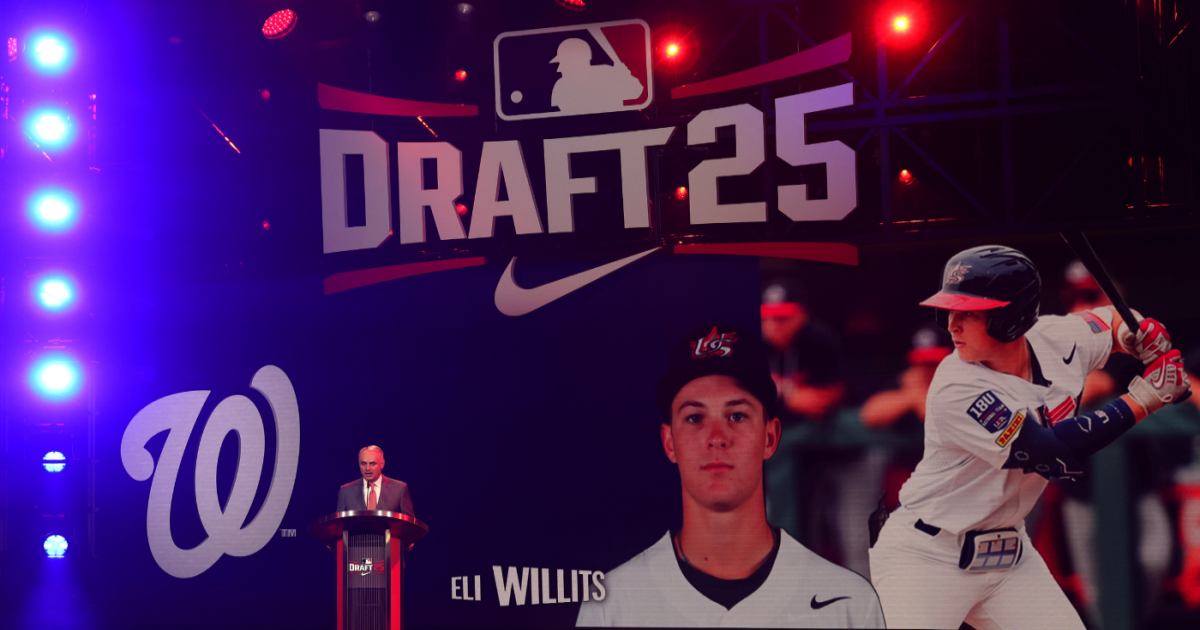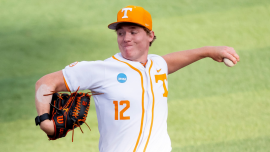LaViolette entered the spring in the running for the top selection. He then suffered through a tough year that culminated with a fractured hand in his second-to-last game. He has extreme power and discipline and equally extreme swing-and-miss tendencies. There’s some tantalizing right-tail outcomes in play here, but there’s at least an equal amount of barren left-tail possibilities. Given that it’s the last pick of the first round, I don’t have much issue with the swing. Grade: B+
Wood hasn’t shown much in the way of durability, and him slipping to the tail-end of the first suggests teams have real reservations about that changing. Still, he has electric stuff and, if he does somehow stay healthy, he has the talent to become the best pitcher in the class. I’ll always appreciate a big swing, even if I recognize this one probably won’t pay off in whole. Grade: B+
Schoolcraft is a 6-foot-8 lefty who really gets down the mound, creating flatter-than-expected angles. His velocity waned at times this spring, otherwise he would’ve been selected higher than this. He was also an interesting prospect as a first baseman, giving him a Plan B if pitching doesn’t work out. Grade: B
Yost is a low-frills infielder with very good bat-to-ball skills. This is a bit earlier than I anticipated him going, but he continued to gain helium all spring into summer. Grade: B-
Gamble was also a late cut for the top 30. He’s a good athlete who shows strong offensive foundational skills flowing from an easy left-handed swing. Grade: B-
Southisene is a dynamic player who combines up-the-middle athleticism with an aggressive operation that sees him swing to make damage. He’s part of a loaded prep infielder class, and he was in consideration for making my top-30 list. Grade: B-
Neyens has middle-of-the-order upside thanks to his double-plus power. Alas, he swings and misses a lot, and he had some just-OK showcase events against better competition. Consider him a boom-or-bust prospect. Grade: B
I had Fischer as a riser despite the likelihood he’ll end up at first base as a professional. Why? Because he performed in the SEC; posted solid advanced metrics across the board; and this is a weak crop of college bats. Grade: B-
The Orioles have a ton of picks. Irish is a good starting point. It’s unclear if he’s going to catch at the next level — he spent most of this season in the outfield after fracturing his shoulder blade — but he can really, really hit. Evaluators praised his all-fields approach and adaptability, and believe he should be a good defensive outfielder if he takes to the grass on a permanent basis. Grade: B+
Cunningham is an advanced lefty hitter with some positional questions. Scouts I spoke to believe he’ll likely shift to either second base or center field as a professional, meaning he’ll still be able to contribute value on both sides of the ball. On the negative side: Cunningham turned 19 in June, making him a little old for a prepster. Grade: B
Conrad is a potentially fun offensive player who has a good feel for contact and legit strength. He was limited to just 21 games after transferring from Marist on account of a season-ending shoulder injury. Clearly the Cubs feel fine about his chances of making a full recovery. This could, in time, prove to be a value get. Grade: B
Houston doesn’t have as much power as his 15-homer season indicates — he recorded just two extra-base hits across 27 Cape Cod League contests last summer — making it an open question as to how his bat will fare against professional pitching. The scouts I spoke to were split on whether he was actually a plus shortstop defender, too. This is right around where I expected him to go, so it’s hard to knock the pick even with the uncertainty on both sides. Grade: B-
I had Witherspoon as the top-ranked righty in the class — blame it on Bremner’s uneven year and Gage Wood’s shoulder injury. He has a deceptively short arm stroke that he uses to chuck a full arsenal, including mid-to-upper-90s fastballs and three breaking pitches (slider, curve, and cutter). This is good value at pick 15. Grade: A
This is just a little higher than I expected Pierce to go. While I have to ding him for being 19 years old already, he’s an instinctual player — a coach’s son, mind you — who’ll stick at shortstop. Offensively, he’s hit-over-power. Grade: B-
At first blush, Kilen looks like a safe collegiate middle infielder with a quality bat. I was lower on him than others because he didn’t play well in either SEC play or last summer’s Cape Cod League — two telltale performance indicators when it comes to collegiate hitters. Grade: C-
Fien is a projectable right-handed hitter with good strength and advanced discipline. He’s probably not going to stick at shortstop as a professional, but the bat gives him a higher ceiling than his draft slot indicates. Grade: B
Arnold was my No. 1 prospect entering the spring: a low-slot lefty who delivers four pitches (including two good fastballs and a slider) on a flat plane. He didn’t have as good of a season as evaluators expected, but this is a good value pick at this stage of the draft. Grade: A
Carlson is a slick fielder who’ll undoubtedly remain at shortstop. Offensively, his swing is geared for line drives, even if he does have legit power potential. There’s a chance — not a guarantee, but a chance — that he has five average or better tools. I think this is a good value at this point. Grade: A
This is a little higher than I anticipated Hall going — I had him ranked behind a few other prep infielders, including Billy Carlson. There are legitimate concerns about his hit tool, with one veteran scouting telling me he didn’t have him as a first-rounder. Hall is an elite runner with power potential and he won’t turn 18 until later this month. There’s big upside here — big downside as well. Grade: C
Parker gained helium throughout the spring on account of his potentially above-average bat and likelihood of remaining on the infield (though probably not at shortstop). Fun fact: his brother Jacob, an outfielder, is also in this class. Grade: B
Arquette is listed as a shortstop, which means he could become just the fourth player of at least his size (6-foot-5) to appear in 50 or more games at shortstop in a single season since the wild card was coined — and only Elly De La Cruz remained there for long. My guess is that he ends up at third base.The real draw here is that Arquette has good power, albeit with his own set of swing-and-miss concerns that could hamper his overall output. Grade: B
Hernandez checks off a lot of the boxes you’d want with a potential plus starting pitcher: velocity, huge build, and a shockingly good changeup for a prepster. I am knocking this pick just a little because … well, the historical attrition rate of prep right-handers is terrible. This is a home-run swing, but I’m not sure he was the best possible selection given how his risk profile stacks up against some others still on the board. Grade: B-
Doyle is a fascinating pitcher. He has probably the best heater in the class, but he’s highly dependent on that offering at a time when MLB teams favor non-fastballs. (To be fair, he does have other pitches; he just didn’t need to use them often.) Between that and a propulsive delivery, Doyle might’ve been typecast as a reliever 15 years ago. Instead, he’ll get a chance to develop into a plus starting pitcher. Grade: A
Holliday marries a good approach with big-time strength from the left side. He’s not going to remain at shortstop, however, and there’s enough swing and miss in his game to give evaluators some pause. I think it’s a fine pick for the Rockies, especially with how tough it is for any pitcher to be a “good” fit in Coors Field. Grade: A
Anderson would have been a defensible No. 1 pick. He’s an SEC-vetted lefty with four above-average offerings who ought to be in the majors by this time next year. It doesn’t hurt his chances of having a long career that the Mariners have demonstrated they’re highly skilled at pitching development. Grade: A
The Angels have reliably gone slot or under with their first-round picks in recent years, all the while emphasizing collegiate talent that could move quickly. I have to assume the former is the case here, too — the latter sure is. Bremner, who entered the spring in contention for the top of the draft, has an elite changeup and saw his performance tick up late in the year after rediscovering his fastball. I think there were better arms available, but that doesn’t necessarily make this a bad pick — it just depends on how much the Angels saved and who they use it on later. Grade: C
I didn’t think the Nationals had the stomach to take a 17-year-old, but I applaud the decision. Willits is the best prospect in the class, in my opinion. He’s a well-rounded switch-hitter with the potential for four above-average or plus tools (everything but power). He also won’t turn 18 until December, and there’s plenty of research out there showing that this kind of competency at such a young age tends to be a positive indicator of future success — Mike Trout and Francisco Lindor, for instance, were both drafted as 17-year-olds. This is the kind of long-term decision you want a team picking No. 1 to make. Grade: A
Commissioner Rob Manfred was booed as he walked to the podium to deliver his opening remarks. The draft has officially begun. The Nationals are on the clock.
There’s no clear-cut best draft candidate this year, lending some more intrigue to the night. Will the Nationals focus on a college player who could be in the majors sooner or a high schooler they can mold and develop? Hitter or pitcher? With a new interim GM, our guess is as good as anyone’s.
Kade Anderson is the favorite to go No. 1. Ethan Holliday is the best-known name in the draft. But the best player? According to our R.J. Anderson, that is high school shortstop Eli Willits. Here are Anderson’s complete top-30 player rankings:


